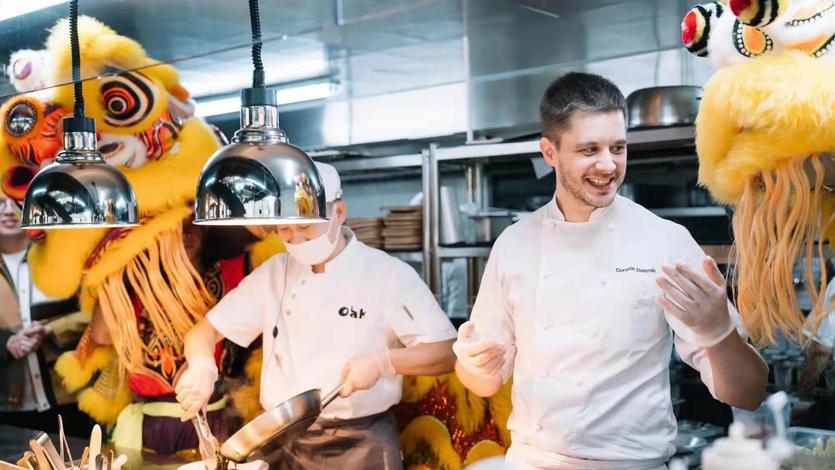Having found his passion for cooking in China, French chef and entrepreneur Corentin Delcroix now wants to be a bridge between the two cultures, He Qi reports.
 French chef Corentin Delcroix at a street stall creates his own version of jianbing. (PHOTO PROVIDED TO CHINA DAILY)
French chef Corentin Delcroix at a street stall creates his own version of jianbing. (PHOTO PROVIDED TO CHINA DAILY)
The Chinese pancake, or jianbing, is one of the most common breakfast foods in northern China. Usually filled with ingredients like crispy fritters, chili paste, vegetables and eggs, this almost ubiquitous dish rarely creates a storm on social media.
French chef Corentin Delcroix's rendition of this beloved snack, however, has been doing exactly that. Since it was uploaded on social media platform Sina Weibo on Aug 9, the tidbits video of him creating his own version of jianbing has been viewed about 250,000 times so far.
I always feel that there might be cultural barriers when Chinese chefs introduce their local cuisine to foreigners. It might be much easier for a foreigner to explain.
Corentin Delcroix, French chef
But just how does his version differ? It is packed with cheese, ham, pickle and black truffle mayonnaise-ingredients typically found in French crepes, which Delcroix says aren't all that different to Chinese pancakes.
The Frenchman is no stranger to many local foodies. His other posts on Sina Weibo that document his attempts at whipping up local dishes like pan-fried bun stuffed with pork and Shanghai vegetable rice have been well-received.
Born in Douai, a city in northern France, Delcroix wears more than just a chef's hat. Boasting 1.3 million followers on Sina Weibo, nearly 1.4 million followers on video-sharing platform Douyin and close to 460,000 on the short-video platform Bilibili, he can be considered as a social media influencer in China.
He is also the founder of Black Olive, a company that helps create new and original dishes for restaurants and food companies. Its clients include Wanchai Ferry, Lacesar Pizzaria, Dr Cheese and Ikea.
 The chef (right) prepares his distinctive menu. (PHOTO PROVIDED TO CHINA DAILY)
The chef (right) prepares his distinctive menu. (PHOTO PROVIDED TO CHINA DAILY)
Delcroix's fascination with Chinese cuisine started in 2002 when he was studying business administration in Beijing. After learning how to prepare some of the popular local dishes, Delcroix found himself intrigued with the differences between Chinese and French cuisines. He noted that the former had a more complex preparation process and a big emphasis on heat control. French cuisine, in contrast, was more about rhythm instead of heat.
"The first Chinese dish I learned to cook was scrambled eggs with tomatoes," says Delcroix, who is married to a Shanghai resident. "But my favorites are cooked wheat-based foods such as dumplings and steamed stuffed buns."
This experience did more than just whet his appetite-it convinced him to become a chef. After graduating, Delcroix returned to France to learn the culinary arts. In 2010, he traveled to Shanghai where he worked as a chef at the restaurant in the France's Rhone-Alpes pavilion of the 2010 World Expo before becoming a teacher at the Shanghai branch of the renowned culinary school Institut Paul Bocuse.
Three years ago, Delcroix decided to share his favorite Chinese and French dishes on social media. Many of his posts show him preparing dishes that marry elements of both cuisines. For example, he recently created clay pot rice with black truffle and beef marrow, and preserved vegetables with foie gras.
But this endeavor is not just about self-promotion-Delcroix says he has also managed to learn more about Chinese cuisine through the comments that he receives from his viewers.
"It is through the viewers that I get to learn how to create a local dish that is truly authentic. I also get to learn about the market sentiment and the kind of dishes that appeal to the local palate. The feedback I get from netizens is faster and more direct than that from the market," Delcroix says.
"Foreign chefs always ask me about Chinese food recipes, and local chefs always want to know about French cuisine. But I always emphasize that recipes don't necessarily lead to good dishes," he adds.
"Take for example luzhu (boiled pork giblets), a dish from Beijing. If you don't understand the tradition behind it, all you will get is just a nice-looking dish, not a delicious and authentic one."
As part of his job to perform research and development of new dishes for his clients, the Frenchman often travels to other Chinese cities.
Over the years, the 39-year-old has traveled to Sichuan province to experience the spiciness of the famed local hotpot, to the open-air teahouses in Chengdu, Sichuan, to sample tea, and to the night markets in Beihai, Guangxi Zhuang autonomous region, to find new flavors and ingredients.
Despite having learned so much about Chinese cuisine over the years, Delcroix says he is still hungry for more knowledge.
"I really want to learn how to stir fry using a big wok, just like how those chefs in restaurants do," he says.
Looking ahead, he wants to do more to promote Chinese cuisine to people overseas.
"I always feel that there might be cultural barriers when Chinese chefs introduce their local cuisine to foreigners. It might be much easier for a foreigner to explain," he says. "I want to be that bridge."
Contact the writer at heqi@chinadaily.com.cn


